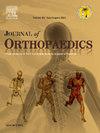Bone marrow aspirate concentrate (BMAC) harvested in the axial and appendicular skeleton does not differ in progenitor cell count: A systematic review and meta-analysis
IF 1.5
Q3 ORTHOPEDICS
引用次数: 0
Abstract
Introduction
Bone marrow aspirate concentrate (BMAC) is a reliable source of progenitor cells that facilitate healing, and it is typically harvested from the iliac crest. The purpose of this systematic review and meta-analysis was to compare total nucleated cell (TNC) count and the presence of colony-forming units (CFUs) in BMAC harvested from axial versus appendicular harvest sites.
Methods
In accordance with Preferred Reporting Items for Systematic Reviews and Meta-Analyses (PRISMA) guidelines, PubMed, Embase, and Cochrane Library databases were searched in August 2024 for studies published after 2004. Studies were included if they evaluated cell counts within BMAC samples harvested from males and females of any age and were prospective. Studies that had no reported cell count within BMAC samples, had evaluations of biologic material other than BMAC, or were translational or cadaveric studies, as well as review articles or technical notes, were excluded. Patients were divided into two cohorts based on whether BMAC was harvested from their axial or appendicular skeleton.
Results
The initial search identified 2126 studies, of which 15 non-randomized prospective studies with a total of 583 patients were included. Each study had low risk of bias. In the axial skeleton, TNC counts ranged from 0.1–502 × 106 cells/mL, and CFU concentration ranged from 0 to 807 CFU/mL. In the appendicular skeleton, TNC counts ranged from 0.1–87 × 106 cells/mL and CFU counts ranged from 0 to 802.7 CFU/mL. No significant differences in TNC or CFU count in BMAC harvested from the axial versus appendicular skeleton were observed.
Conclusions
BMAC harvested from the axial and appendicular skeletons demonstrate significant variability in progenitor cell concentration. These findings suggest that harvesting at appendicular sites near the operative location allows the surgeon to extract sufficient quality BMAC as compared to harvest sites within the axial skeleton, such as the iliac crest.
Level of evidence
Level II, systematic review of level II studies.
骨髓抽吸浓缩液(BMAC)在轴骨和尾骨的祖细胞计数没有差异:一项系统回顾和荟萃分析
骨髓抽吸浓缩液(BMAC)是促进愈合的祖细胞的可靠来源,通常来自髂骨。本系统综述和荟萃分析的目的是比较从轴端和尾端收获部位收获的BMAC中有核细胞总数(TNC)和集落形成单位(cfu)的存在。方法根据PRISMA (Preferred Reporting Items for Systematic Reviews and meta - analysis)指南,于2024年8月检索PubMed、Embase和Cochrane Library数据库,检索2004年以后发表的研究。如果研究评估了从任何年龄的男性和女性收集的BMAC样本中的细胞计数,并且是前瞻性的,则纳入研究。在BMAC样本中没有报告细胞计数的研究,对BMAC以外的生物材料进行了评估,或翻译或尸体研究,以及评论文章或技术说明,均被排除在外。根据BMAC是从中轴骨还是从附肢骨骼取出,将患者分为两组。结果初始检索共纳入2126项研究,其中15项非随机前瞻性研究,共纳入583例患者。每项研究的偏倚风险都很低。轴向骨架TNC计数范围为0.1 ~ 502 × 106细胞/mL, CFU浓度范围为0 ~ 807 CFU/mL。阑尾骨骼TNC计数范围为0.1 ~ 87 × 106 cells/mL, CFU计数范围为0 ~ 802.7 CFU/mL。从中轴骨和附肢骨采集的BMAC中,TNC或CFU计数无显著差异。结论从轴骨和尾骨采集的sbmac在祖细胞浓度上存在显著差异。这些研究结果表明,与在轴骨(如髂骨)内的收获部位相比,在手术部位附近的阑尾部位收获可以使外科医生提取足够质量的BMAC。证据等级:II级,II级研究的系统评价。
本文章由计算机程序翻译,如有差异,请以英文原文为准。
求助全文
约1分钟内获得全文
求助全文
来源期刊

Journal of orthopaedics
ORTHOPEDICS-
CiteScore
3.50
自引率
6.70%
发文量
202
审稿时长
56 days
期刊介绍:
Journal of Orthopaedics aims to be a leading journal in orthopaedics and contribute towards the improvement of quality of orthopedic health care. The journal publishes original research work and review articles related to different aspects of orthopaedics including Arthroplasty, Arthroscopy, Sports Medicine, Trauma, Spine and Spinal deformities, Pediatric orthopaedics, limb reconstruction procedures, hand surgery, and orthopaedic oncology. It also publishes articles on continuing education, health-related information, case reports and letters to the editor. It is requested to note that the journal has an international readership and all submissions should be aimed at specifying something about the setting in which the work was conducted. Authors must also provide any specific reasons for the research and also provide an elaborate description of the results.
 求助内容:
求助内容: 应助结果提醒方式:
应助结果提醒方式:


